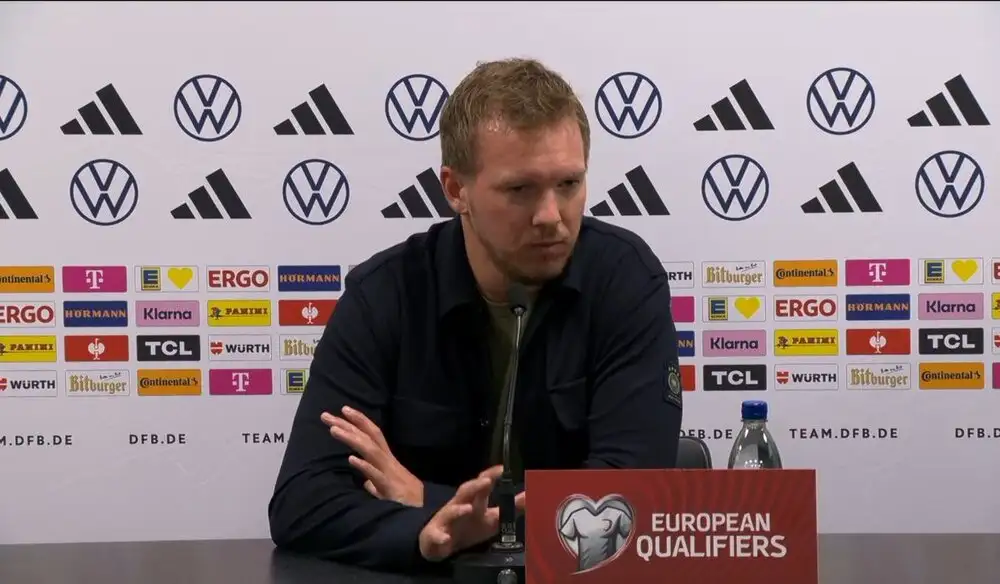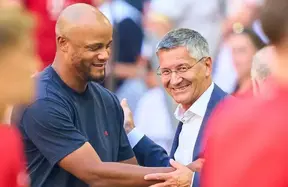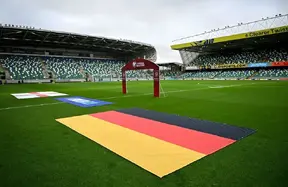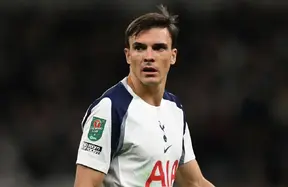Germany head coach Julian Nagelsmann has reaffirmed the value of a strong "Bayern block" in the national team while stressing that Borussia Dortmund’s core is equally crucial. Ahead of the next international fixture, he praised Bayern’s confidence and form, and signaled continuity by planning to keep the same starting XI that impressed against Luxembourg. The stance points to chemistry-first team building, rewarding clubs that field many German starters. Fan debate immediately flared around roles for key names from both clubs, underlining how the Bayern–Dortmund axis continues to shape the identity and ceiling of Die Mannschaft under Nagelsmann.

Speaking to reporters before Germany’s next international match, Julian Nagelsmann emphasized the importance of club blocks—especially Bayern Munich’s and Borussia Dortmund’s—in building cohesion for the national team. He indicated he is set to retain the same starting eleven that began the recent win over Luxembourg, highlighting form, familiarity, and confidence as selection drivers. The remarks arrive amid an international window where performances and minute management for leading club contributors are being closely scrutinized.
Nagelsmann on having a big 'Bayern block' again in the national team: "This Bayern block is important. But so is the Dortmund block. For us, all teams that have many German players in their starting lineup are important. Bayern are doing very well and have good confidence at the
@iMiaSanMia
Impact Analysis
Nagelsmann’s endorsement of a “Bayern block” alongside a meaningful Dortmund core signals a return to Germany’s historical blueprint: consolidate synergy by leveraging entrenched club chemistries. In tournament football, where rehearsal time is limited, pre-existing automatisms can translate into quicker collective reactions, cleaner pressing triggers, and more consistent zone occupation—particularly in rest-defense and build-up. Bayern’s structure provides high-tempo pressing patterns and vertical combinations; Dortmund’s cohort contributes athleticism, ball-carrying in transition, and aerial presence.
Locking in the same XI that dispatched Luxembourg enhances continuity, but also elevates the internal meritocracy: form and familiarity will trump reputational selection. This could stabilize roles for Bayern staples—whether it’s leadership from Manuel Neuer, control and distribution via Joshua Kimmich and Leon Goretzka, or final-third incision from Jamal Musiala—while giving Dortmund figures like Nico Schlotterbeck a defined defensive brief and build-up responsibility on his preferred side.
There are strategic trade-offs. Over-reliance on any single club block can narrow tactical variance and complicate integration for standout performers from other Bundesliga sides. Yet the blended Bayern–Dortmund spine, if balanced properly, can reduce error margins in high-stakes phases: set-piece organization, counter-press recovery, and defensive line coordination. In the short term, maintaining the winning XI curbs uncertainty; medium term, it challenges external candidates to dislodge an increasingly synchronized unit on pure performance grounds.
Reaction
Fan discourse split quickly along familiar lines. Supporters favoring club chemistry applauded a Bayern-led core, arguing it guarantees instant cohesion and a higher floor in international play. Others pushed for equilibrium, insisting Dortmund’s contributions—particularly Nico Schlotterbeck’s distribution and aggression—are non-negotiable for a modern back line. One thread urged the staff to stop "experimenting" and fully commit to a clear identity rooted in dominant club structures, while another warned against overplaying Bayern regulars for 90 minutes each outing amid a crowded calendar.
There were pointed calls about individual usage: some fans argued for managing Leon Goretzka’s minutes, citing balance in midfield and the need to keep peak intensity late in games. Another camp highlighted defenders’ form as the decisive selection criterion, contending that a Schlotterbeck-led axis can tidy Germany’s rest-defense and unlock cleaner progression. Outside the core debate, a flurry of comments celebrated positive club-level momentum—like a loanee goalkeeper’s penalty heroics—seeing it as a barometer of confidence feeding into the national setup.
Overall, the community welcomed the announcement of an unchanged XI as a sign of clarity, yet it remains vocal about micro-choices: who partners whom at center-back, whether Kimmich’s role is best at right-back or central midfield, and how to alternate creators to preserve sharpness across the window.
Social reactions
Soon Bischof and Neuer
Robin (@Robindesboiskek)
You will see next weekend why Dortmund and Bayern block is N O T the same
Lasse - MEGA - e/acc (@Iassediercks)
Nico Schlotterbeck on playing alongside Jonathan Tah: "He's very communicative on the pitch. He's been an extremely strong defender for years and has done very well. I've known him for years, we played a few games together. I'm always happy to play alongside him. I think we
Bayern & Germany (@iMiaSanMia)
Prediction
Short term, expect Nagelsmann to double down on continuity: the same XI offers a stable platform for layered automatisms—staggered midfield heights, synchronized pressing cues, and rehearsed set-piece routines. A Bayern-leaning backbone likely drives the default structure: Neuer’s command, Kimmich’s orchestration, Goretzka’s box-to-box coverage, and Musiala’s lane-changing runs. Dortmund’s imprint should be visible in the defensive line’s aggression and progressive passing, with Schlotterbeck a prime candidate to initiate diagonals and break the first press.
As the window progresses, rotation will hinge on game state and opponent profiles. Against deep blocks, Nagelsmann could introduce a technician to amplify between-the-lines presence; versus transition-heavy opponents, he may prioritize ball-winners and aerial security. Expect selective minute management for high-load Bayern names to avoid fatigue, while giving in-form Dortmund contributors expanded responsibility in central defense and the left channel.
Medium term, the staff will broaden integration to standout performers from other Bundesliga sides, but without diluting the core. The likely scenario is a 70–30 blend: a Bayern–Dortmund spine complemented by specialists—press-resistant eights, wide isolators, and set-piece threats. If performance metrics (field tilt, PPDA, final-third entries) trend upward, Nagelsmann will keep changes minimal, reserving structural tweaks for late-tournament contingencies and specific matchup tailoring.
Latest today
- Official: Lucas Paqueta ruled out for West Ham vs Manchester United on Thursday
- Rival view: Luke Shaw’s availability problem hands Man United another headache
- Valverde’s son copies Cristiano Ronaldo’s ‘Siuu’ celebration - proof CR7’s influence still...
- Arsenal’s Rice-Caicedo what-if ignites push for Zubimendi as Arteta sharpens midfield plan
Conclusion
Nagelsmann’s message is unambiguous: Germany’s path back to ruthless, reliable tournament football runs through coherent club blocks, with Bayern’s familiarity and Dortmund’s edge forming the bedrock. By sticking with a winning XI, he trades experimentation for execution, inviting players to master roles rather than audition for them. That choice should lift the team’s collective IQ—faster reads, fewer unforced errors, and crisper transitions—especially against compact opponents.
The fan debate is healthy and expected. But beneath the noise lies a constructive alignment: most agree that identity and continuity have been missing ingredients. The current approach restores both, while leaving room for merit-based entry from elsewhere. If the balance holds—Bayern’s control plus Dortmund’s verticality—Germany can harden its spine, stabilize performance between windows, and re-enter major tournaments with a clear blueprint. In that light, the Bayern–Dortmund axis is not a rivalry within the team; it is the partnership that can make the whole greater than the sum of its parts.













Robin
Soon Bischof and Neuer
Lasse - MEGA - e/acc
You will see next weekend why Dortmund and Bayern block is N O T the same
Bayern & Germany
Nico Schlotterbeck on playing alongside Jonathan Tah: "He's very communicative on the pitch. He's been an extremely strong defender for years and has done very well. I've known him for years, we played a few games together. I'm always happy to play alongside him. I think we
Porto Tonic
Dortmund block? Sounds like a good way to guarantee failure...
Muhirwa Salomon
"This Bayern block is important. But so is the Dortmund block. For us, all teams that have many German players in their starting lineup are important. Bayern are doing very well and have good confidence..." ⚽🇩🇪
Jerry
Every single time, if you value FCB and BVB's German player you will have significant progress in international stages. If you don't, pack stuffs and order a plane ticket now. Stop experimenting, just play either Kompany ball or Kovac ball.
hiba | 🎨
The important Dortmund block is basically Schlotterbeck tbf, this guy is so important for the NT
Daan
Yeah stop playing our players for 90 min fathead
Ardi 🇦🇱
We really wouldn’t mind if you stop playing goretzka tho
Victor Catalina
Did Bayern give up on him too soon? 🇦🇺
𝘽𝙚𝙣𝙟𝙞𝙁𝘾𝘽 ¹⁷
Just love the way James Rodriguez & Luis Diaz celebrating together. Bayern Munich in their DNA.😍
Bayern Focus
🚨💣 According to 's estimates, extending Upamecano on the Frenchman's terms (salary and signing bonuses) would cost roughly the same as buying Nico Schlotterbeck (transfer fee and salary) ! 🤯
Bayern & Germany
New head of rehab Benjamin Sommer added a new €18k device called “Sprint 2” to the rehab sessions. With this machine, the players can complete runs and sprints with precisely adjusted resistance – all digitally controlled and analyzed directly, with data monitoring on an iPad.
OneFootball
Thomas Müller is loving life in MLS 💥 📸: Imagn Images
Bayern & Die Mannschaft
Bayern loanee Daniel Peretz saves two Haaland penalties 🎥
10 Minute Drill
📊 New Poll: Voters call on Democrats to end the Schumer shutdown A new poll finds voters overwhelmingly oppose the Democrat shutdown, believe Democrats should accept Republicans clean funding bill, and believe Democrats shut down is all about "trying to please their base."